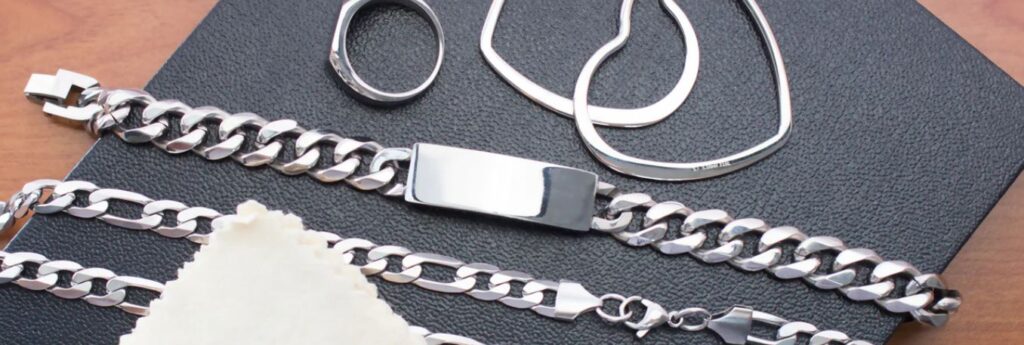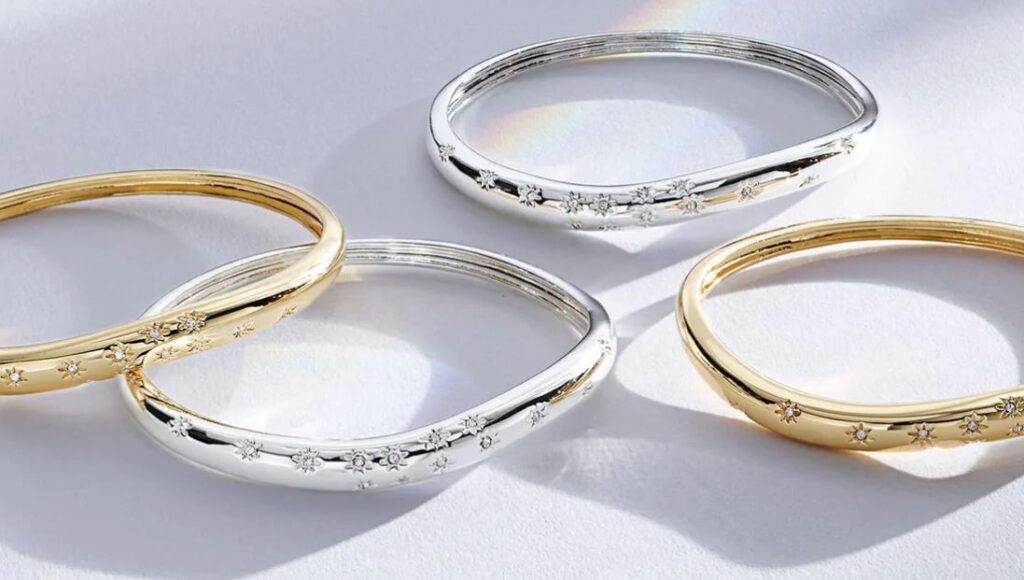Stainless Steel vs Sterling Silver
Stainless steel is a better option than sterling silver as it does not tarnish and is completely hypoallergenic. Stainless steel’s appearance is more whiter than sterling silver and can also resistant better against scratches. Sterling silver is a metal if you are looking for traditional designs and availability.
In this article we’ll do a detailed comparison of stainless steel vs sterling silver.
We’ll go through questions like is stainless steel better than sterling silver, what benefits one has over other and what should you buy.
Stainless Steel
Stainless steel is an alloy made from iron, chromium, and often nickel. The chromium content, which is usually at least 10.5%, is what makes stainless steel resistant to tarnishing and corrosion. There are several grades of stainless steel being used in jewelry i.e. 304, 316 and 316L.
Each grade is known for somewhat different properties to other. For example, 316-grade stainless steel is more resistant to corrosion, particularly in harsh environments like coastal areas. This makes this type of stainless steel one of the toughest for jewelry making.

Properties of Stainless Steel
Stainless steel has the following set of properties.
Durability
Stainless steel is one of the most durable and toughest materials. It has an impressive strength to offer against damages like scratches, cracking and breaking. This makes it an ideal choice for one who wants maximum durability with affordable price.
Versatility
It can be used in various finishes including brushed, polished, or matte, which adds to its aesthetic versatility. Apart from this stainless steel can be customized in any way you like.
Hypoallergenic
Stainless steel does not cause any kind of skin allergies and can be worn by people with sensitive skin. Allergic behavior is mainly caused by metals with high quantities of nickel or copper.
Tarnishing Resistance
Stainless steel’s chromium content creates a thin layer of chromium oxide on the surface, which protects the metal from rust, corrosion and tarnishing.
Sterling Silver
Sterling silver is an alloy of silver which contains 92.5% pure silver and 7.5% other metals, usually copper. This combination maintains the desirable properties of silver while adding strength and durability. Sterling silver has been used for centuries in jewelry, coins, and decorative items, revered for its classic and elegant appearance.
This composition enhances its durability while preserving its beauty and luster. Throughout history, sterling silver has been a symbol of wealth and refinement, prized for its aesthetic appeal and intrinsic value.

Properties of Sterling Silver
Here is an overview of prominent properties of sterling silver.
White Appearance
It has a natural, brilliant shine that many find attractive. However, this shine can tarnish over time due to sulfur compounds in the air.
Customization
Sterling silver is more malleable and can be easily shaped into intricate designs, making it ideal for fine jewelry and detailed craftsmanship.
Tarnishing
Tarnishing is a chemical reaction in which metal reacts with atmospheric chemicals and forms an a hard thick unwanted layer. This overall decreases the shine and glamorous appearance of your jewelry item. Silver is one of those metals which can be tarnished.
Stainless Steel vs Sterling Silver – A Detailed Comparison
Here is a detailed comparison of sterling silver vs stainless steel.
1. Durability
Stainless steel is highly resistant to scratches, rust, corrosion and tarnishing. This makes it an ideal choice for a wide range of jewelry designs.
Sterling silver, while beautiful and prized for its appearance, is comparatively softer and less durable than stainless steel. It is more prone to scratches and dents, and over time, it may lose its original luster due to tarnishing. Yes, this tarnishing can be undone by using commercial chemicals but it increases the overall care to be taken of.
2. Aesthetic Appeal
Stainless steel is often chosen for its modern and sleek appearance. It has a contemporary look that complements various design styles. The material can be finished in numerous ways, including brushed, polished, or even blackened, allowing for a range of aesthetic choices.

3. Easiness for Daily Wear
For everyday wear, stainless steel is often preferred due to its resistance and low maintenance properties. It is less likely to scratch or tarnish, making it ideal for items. Its hypoallergenic properties also make it a suitable choice for individuals with sensitive skin.
Sterling silver is highly favored for its aesthetic qualities in jewelry. However, due to its softness, it is more susceptible to wear and tear compared to harder metals. Sterling silver items, such as antique coins and elaborate pieces, often gain value over time due to their artistic ability and historical significance.
4. Resale Value
Sterling silver jewelry has a more resale value than stainless steel jewelry. Sterling silver can be bought or sold in any of the store dealing in silver jewelry. Factors like market price, demand and others can vary what price will you get.
Stainless steel jewelry is a commonly available metal. So, resale market does not exist at that level. That’s why stainless steel jewelry has none to very little resale value.

5. Cost
Stainless steel is generally more affordable than sterling silver. It is an economical choice for many wanting to wear jewelry in their daily life.
Sterling silver is more expensive due to the intrinsic value of silver. But difference of price is not that much. If you get a stainless steel ring for $25, same ring in sterling silver will be around $40.
Conclusion
Sterling silver has a dual purpose of wearing i.e. daily life and precious jewelry. It is up to you to decide what to do with it. If you will not wear it on daily purpose, then it is prefect choice. But if you want to wear on daily basis, then be ready for cleaning of jewelry at least once in a month.
Stainless steel is a perfect choice for one who wants to wear jewelry on daily basis. It is affordable, damage resistant and hypoallergenic. This makes it best for one who is looking to elevate their fashion with a lot of useful properties.

